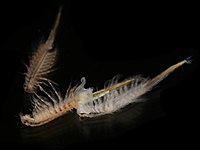
Localization patterns of dopamine active transporter synthesizing cells during development of brine shrimp.
Sign Up to like & getrecommendations! Published in 2017 at "Archives of insect biochemistry and physiology"
DOI: 10.1002/arch.21378
Abstract: There have been many studies on dopamine active transporter (DAT) in humans and laboratory animals; however, there is a lack of information on DAT in brine shrimp. In this study, we demonstrated the neuronal and… read more here.
Keywords: brine shrimp; cells development; development brine; brine ... See more keywords

Effects of ingested polystyrene microplastics on brine shrimp, Artemia parthenogenetica.
Sign Up to like & getrecommendations! Published in 2019 at "Environmental pollution"
DOI: 10.1016/j.envpol.2018.10.024
Abstract: Microplastics are a contaminant of emerging concern which enter the marine environment from a variety of sources. The ingestion and toxic effects of microplastics on marine life, especially for filter feeders, are a cause of… read more here.
Keywords: parthenogenetica; polystyrene microplastics; artemia parthenogenetica; brine shrimp ... See more keywords

Transcriptomic analysis of brine shrimp Artemia franciscana across a wide range of salinities.
Sign Up to like & getrecommendations! Published in 2021 at "Marine genomics"
DOI: 10.1016/j.margen.2021.100919
Abstract: Brine shrimp Artemia franciscana, a commercially important species, can thrive in a wide range of salinities and is commonly found in hypersaline lakes and solar salterns. Transcriptome analysis can enhance the understanding of the adaptative… read more here.
Keywords: shrimp artemia; expression; brine shrimp; range salinities ... See more keywords

Design, synthesis, brine shrimp lethality and cytotoxicity of some novel 17a-aza-D-homo-androster-17-one derivatives.
Sign Up to like & getrecommendations! Published in 2020 at "Natural product research"
DOI: 10.1080/14786419.2020.1753049
Abstract: In this work, twenty-eight novel 17a-aza-D-homo-androster-17-one derivatives, which divided into two categories, were synthesized with commercial available starting material (dehydroepiandrosterone) via oximation reaction, Beckmann rearrangement, hydroxyl protection, N-alkylation and deprotection. All compounds were characterized by… read more here.
Keywords: aza homo; homo androster; brine shrimp; novel 17a ... See more keywords

ZW sex-chromosome evolution and contagious parthenogenesis in Artemia brine shrimp
Sign Up to like & getrecommendations! Published in 2022 at "Genetics"
DOI: 10.1093/genetics/iyac123
Abstract: Eurasian brine shrimp (genus Artemia) have closely related sexual and asexual lineages of parthenogenetic females, which produce rare males at low frequencies. Although they are known to have ZW chromosomes, these are not well characterized,… read more here.
Keywords: chromosome evolution; sex chromosome; chromosome; sex ... See more keywords

Halogenated Indoles Decrease the Virulence of Vibrio campbellii in a Gnotobiotic Brine Shrimp Model
Sign Up to like & getrecommendations! Published in 2022 at "Microbiology Spectrum"
DOI: 10.1128/spectrum.02689-22
Abstract: Bacterial diseases are a major problem in the aquaculture industry. In order to counter this problem, farmers have been using antibiotics, and this has led to the evolution and spread of antibiotic resistance. ABSTRACT Indole… read more here.
Keywords: indole analogues; activity; virulence; brine shrimp ... See more keywords

Occurrence of a tumour-like abnormality in the telson skeleton of the brine shrimp Artemia (Branchiopoda, Anostraca)
Sign Up to like & getrecommendations! Published in 2019 at "Crustaceana"
DOI: 10.1163/15685403-00003871
Abstract: Malformations of crustaceans have been observed in their natural habitats as well as in laboratory studies. Two patterns of morphological abnormalities have been recorded in species of the brine shrimp genus Artemia, including a gynandromorphic… read more here.
Keywords: telson skeleton; like abnormality; tumour like; brine shrimp ... See more keywords

Six new species of the brine shrimp Parartemia Sayce 1903 (Crustacea: Anostraca: Artemiina) in Western Australia
Sign Up to like & getrecommendations! Published in 2019 at "Zootaxa"
DOI: 10.11646/zootaxa.2715.1.1
Abstract: The Australian anostracan fauna is generically depauperate, but species-rich due to radiation within Branchinella and also Parartemia. Most Parartemia, including the six new species, occur in Western Australia, with P. boomeranga sp. nov. in the… read more here.
Keywords: parartemia; six new; western australia; species brine ... See more keywords

Enzymatic activity and brine shrimp lethality of venom from the large brown spitting cobra (Naja ashei) and its neutralization by antivenom
Sign Up to like & getrecommendations! Published in 2020 at "BMC Research Notes"
DOI: 10.1186/s13104-020-05167-2
Abstract: Naja ashei is a snake of medical importance in Kenya, Ethiopia, Somalia, Uganda, and Tanzania. Little is known about the enzymatic (snake venom phospholipases A2; svPLA2’s) and toxic (lethal) activities of N. ashei venom and… read more here.
Keywords: naja ashei; brine shrimp; activity; shrimp lethality ... See more keywords

Low cytotoxicity, and antiproliferative activity on cancer cells, of the plant Senna alata (Fabaceae)
Sign Up to like & getrecommendations! Published in 2021 at "Revista De Biologia Tropical"
DOI: 10.15517/rbt.v69i1.42144
Abstract: Introduction: The leaves of Senna alata from the Fabaceae family have been used in folk medicine for the cure of skin disease. In this study, we tested the extract and fractions on brine shrimp lethality… read more here.
Keywords: cytotoxicity; cancer; antiproliferative activity; senna alata ... See more keywords

Evaluation of Phytochemicals of Cassia tora Linn. and it’s Cytotoxicity Assay using Brine Shrimp
Sign Up to like & getrecommendations! Published in 2017 at "Phytopathology"
DOI: 10.25258/phyto.v9i4.8132
Abstract: Cassia tora Linn. is a well known medicinal herb found as a rainy season weed throughout India. Various studies have been conducted in order to find out the applications of Cassia tora since many years… read more here.
Keywords: cytotoxicity assay; plant; cassia tora; brine shrimp ... See more keywords